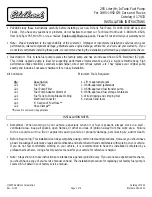
92
SSHandbook
Modifications: Exhaust
Exhaust
The fact is most cars are leaving horsepower on the table. We show you how to get it back.
From the February, 2009 issue ofSuper Chevy
Photography by Various Manufacturers
All contributors: David Vizard
For me the first really serious look at how to muffle a high performance race engine without losing a
significant amount of power started in 1980 when I built a 4001b-ft, 404hp 350 to replace the very lame
158hp 305 in my California-spec Pontiac Trans Am. Having worked very hard to build a pump gas fueled
engine (gas was really bad in those days), that would cross the 400 hp barrier, I was very disappointed to find
that, regardless of what mufflers were used, the output dropped by some 20 Ib-ft and 25 hp. Having had some
experience designing a no-loss system for the original style British Mini Coopers, I felt confident I could pull
offthe same stunt for significantly bigger V-8 engines. The result, aided by an acoustics expert friend, was the
Sonic Turbo. This design went on to be manufactured by Cyclone (now a division ofWalker/Dynomax). After
the smoke cleared from a big muffler shootout (done at Gale Banks facility and published by Hot Rod
magazine), a pair of 2.25-inch Sonic Turbos (the 2.5-inch ones were still a couple of months off) sunk
everybody else's 2.5-inch items. This, it seemed, was just what the hot rod fraternity wanted and they sold by
the hundreds of thousandths. That was good, but more importantly; it appeared to spark the industry into
aggressively pursuing significantly more functional mufflers and exhaust systems. The result is that 20-some-
years later, all the necessary components to build a highly effective, no-loss system are at hand, and not
necessarily that much money either. All that appears to be lacking is widespread know-how as to what is
needed to achieve this happy state ofaffairs. As ofnow, we are going to make a start on putting that right.
Simple Steps to Success
Although the mode of function of an exhaust system is complex, it is not (as so often is believed, even by
many pro engine builders) a black art. To help appreciate the way to get the job done I will go through the
process of selecting exhaust system components for a typical high performance V-8 in a logical manner from
header to tail pipe. Although the entire exhaust
functions as a system, we can, for all practical purposes,
break down many of the requirements that need to be
met into single entities. Fig. 1 details the order of
business. But before making a start, it is a good idea to
establish just why getting the exhaust correctly spec'd
out is so important. This will allow realistic goals,
improved component choice, and a more functional
installation. The V-8 engines we typically modify for
increased output are normally categorized as four-cycle
units. Although pretty much the case for a regular street
machine, this is far from being the case for a high
performance race engine. If we consider a well-
developed race engine, the usual induction,
compression, expansion (power stroke) and exhaust
cycles have a fifth element added (Fig. 2). With a race
cam and a tuned-length exhaust system, negative
pressure waves traveling back from the collector will
This More Performance LS6 relied heavily on the
effectiveness ofthe Nextel Cup-style Kook's long 4-into-2-
short-into-1 headers to bring the entire power production
program together. The result: 726 horsepower!
Exhaust Science Demystified
Summary of Contents for Impala SS
Page 5: ...Maintenance...
Page 11: ...11 SSHandbook Maintenance Chassis Suspension Body bushing locations...
Page 40: ...40 SSHandbook Maintenance Electrical...
Page 61: ...61 SSHandbook Maintenance Fuel System Anice side shot Aview ofthe wiper...
Page 76: ...ModificationSS...
Page 110: ...General Information...
Page 122: ...122 SSHandbook General Information ABITS Opti spark...
Page 134: ...134 SSHandbook General Information ABITS Opti spark...
















































